Report on Recruitment in the Australian Construction Industry
VerifiedAdded on 2020/03/16
|16
|3290
|34
Report
AI Summary
This report investigates the recruitment challenges faced by the Australian construction industry, focusing on factors that negatively impact the sector's ability to attract and retain skilled workers. It explores the issues of labor supply and demand, the industry's image, and demographic factors such as an aging workforce, diversity, and gender imbalances. The report highlights the impact of the 2008 economic recession on the workforce, the negative perceptions of the industry among young people, and the challenges of age-based discrimination. It also addresses issues of ethnic and cultural segregation, and gender inequality within the industry. The report concludes by offering recommendations to combat these challenges, including embracing equality, extending retirement ages, implementing training policies, and launching public relations campaigns to improve the industry's image. The goal is to provide a sustainable labor pool and ensure the long-term success of the construction sector.
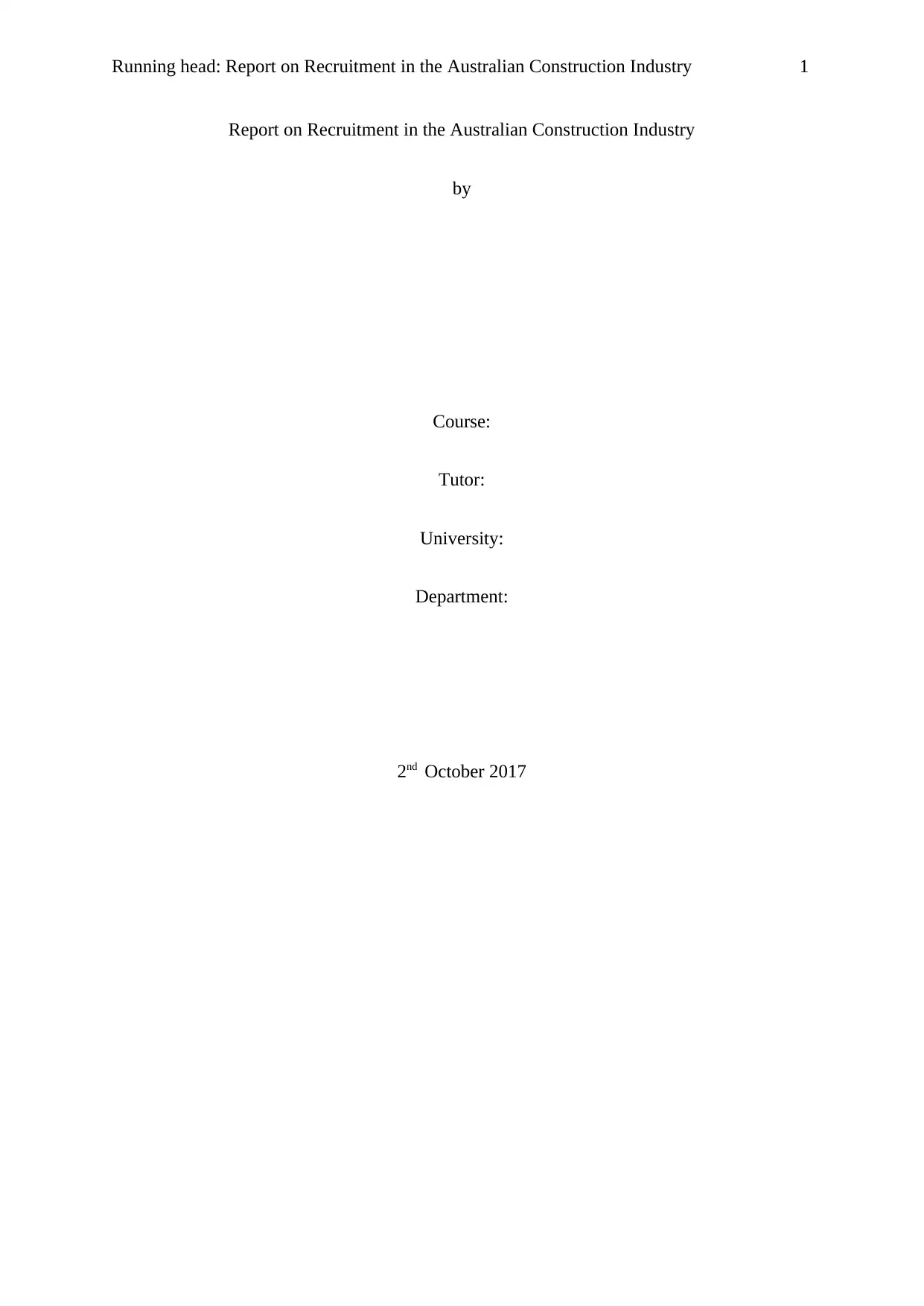
Running head: Report on Recruitment in the Australian Construction Industry 1
Report on Recruitment in the Australian Construction Industry
by
Course:
Tutor:
University:
Department:
2nd October 2017
Report on Recruitment in the Australian Construction Industry
by
Course:
Tutor:
University:
Department:
2nd October 2017
Paraphrase This Document
Need a fresh take? Get an instant paraphrase of this document with our AI Paraphraser
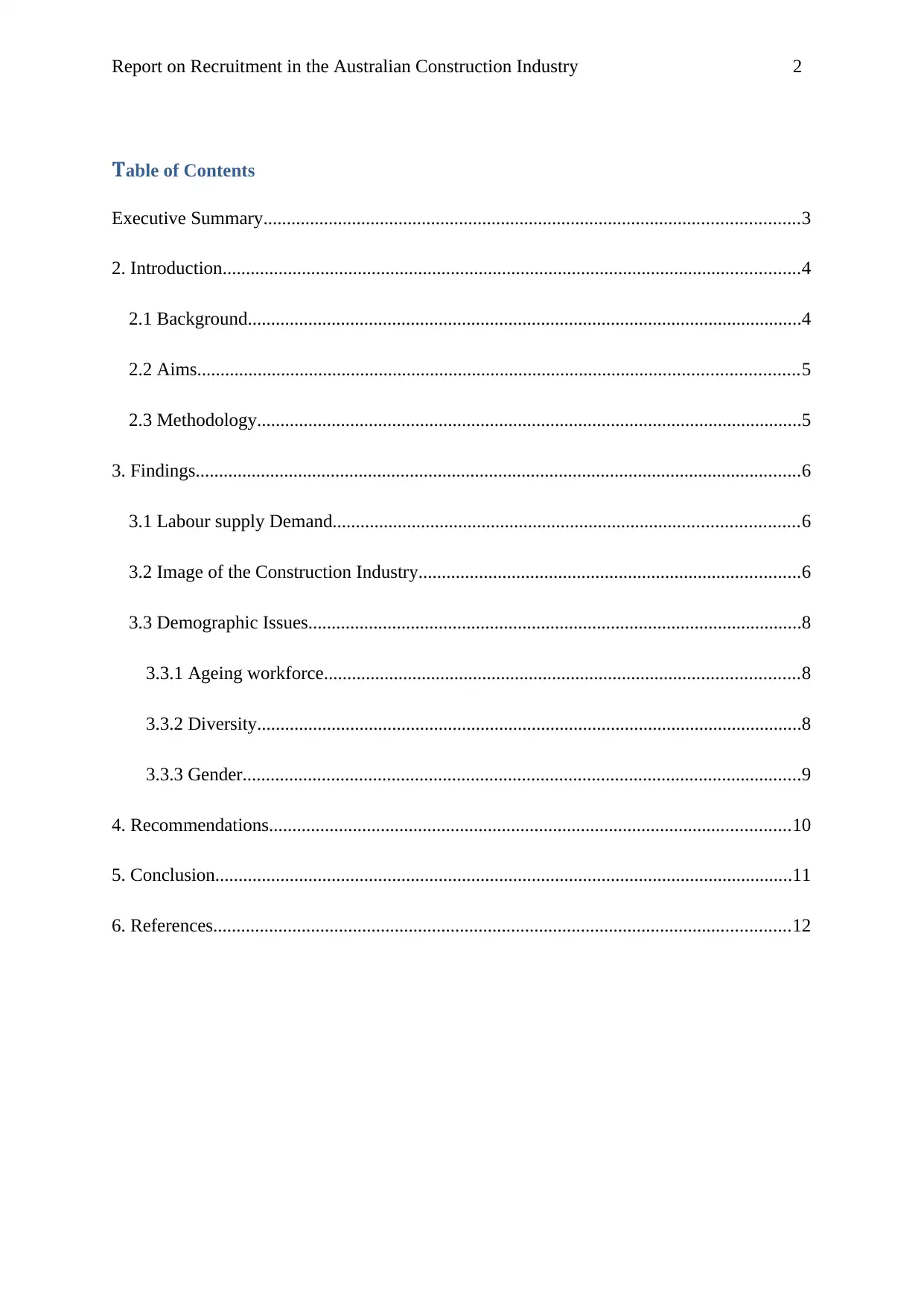
Report on Recruitment in the Australian Construction Industry 2
Table of Contents
Executive Summary...................................................................................................................3
2. Introduction............................................................................................................................4
2.1 Background.......................................................................................................................4
2.2 Aims.................................................................................................................................5
2.3 Methodology.....................................................................................................................5
3. Findings..................................................................................................................................6
3.1 Labour supply Demand....................................................................................................6
3.2 Image of the Construction Industry..................................................................................6
3.3 Demographic Issues..........................................................................................................8
3.3.1 Ageing workforce......................................................................................................8
3.3.2 Diversity.....................................................................................................................8
3.3.3 Gender........................................................................................................................9
4. Recommendations................................................................................................................10
5. Conclusion............................................................................................................................11
6. References............................................................................................................................12
Table of Contents
Executive Summary...................................................................................................................3
2. Introduction............................................................................................................................4
2.1 Background.......................................................................................................................4
2.2 Aims.................................................................................................................................5
2.3 Methodology.....................................................................................................................5
3. Findings..................................................................................................................................6
3.1 Labour supply Demand....................................................................................................6
3.2 Image of the Construction Industry..................................................................................6
3.3 Demographic Issues..........................................................................................................8
3.3.1 Ageing workforce......................................................................................................8
3.3.2 Diversity.....................................................................................................................8
3.3.3 Gender........................................................................................................................9
4. Recommendations................................................................................................................10
5. Conclusion............................................................................................................................11
6. References............................................................................................................................12
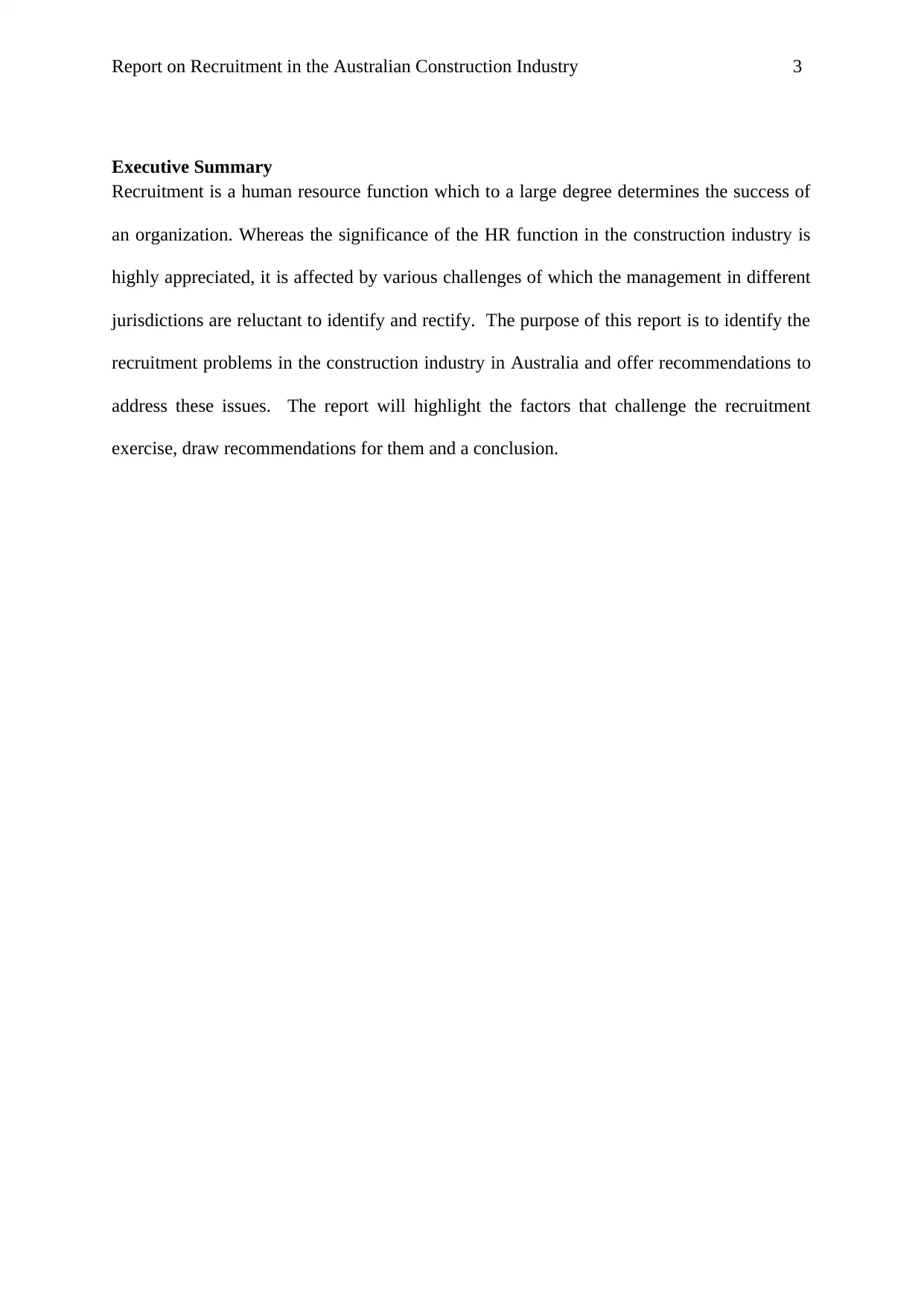
Report on Recruitment in the Australian Construction Industry 3
Executive Summary
Recruitment is a human resource function which to a large degree determines the success of
an organization. Whereas the significance of the HR function in the construction industry is
highly appreciated, it is affected by various challenges of which the management in different
jurisdictions are reluctant to identify and rectify. The purpose of this report is to identify the
recruitment problems in the construction industry in Australia and offer recommendations to
address these issues. The report will highlight the factors that challenge the recruitment
exercise, draw recommendations for them and a conclusion.
Executive Summary
Recruitment is a human resource function which to a large degree determines the success of
an organization. Whereas the significance of the HR function in the construction industry is
highly appreciated, it is affected by various challenges of which the management in different
jurisdictions are reluctant to identify and rectify. The purpose of this report is to identify the
recruitment problems in the construction industry in Australia and offer recommendations to
address these issues. The report will highlight the factors that challenge the recruitment
exercise, draw recommendations for them and a conclusion.
⊘ This is a preview!⊘
Do you want full access?
Subscribe today to unlock all pages.

Trusted by 1+ million students worldwide
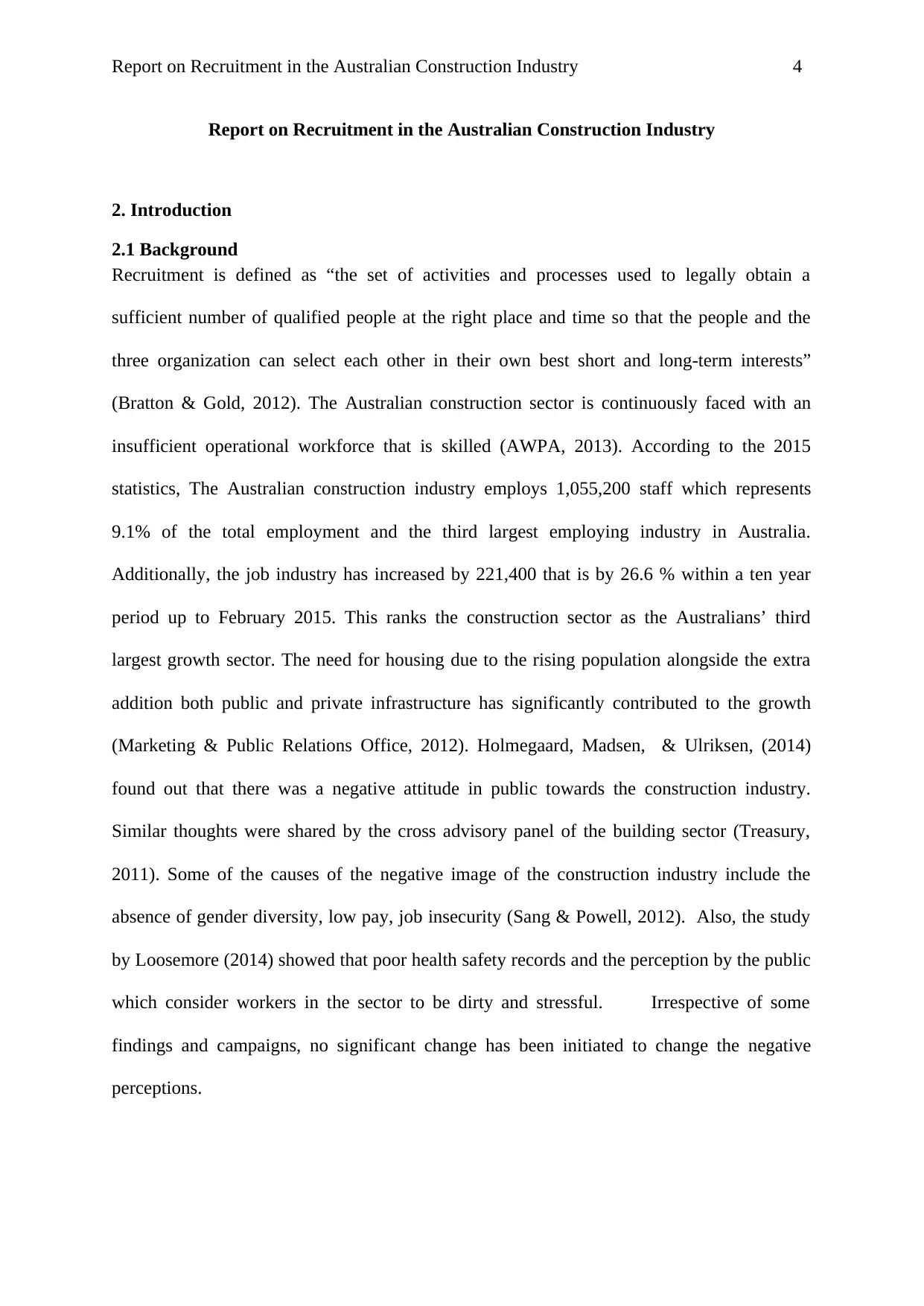
Report on Recruitment in the Australian Construction Industry 4
Report on Recruitment in the Australian Construction Industry
2. Introduction
2.1 Background
Recruitment is defined as “the set of activities and processes used to legally obtain a
sufficient number of qualified people at the right place and time so that the people and the
three organization can select each other in their own best short and long-term interests”
(Bratton & Gold, 2012). The Australian construction sector is continuously faced with an
insufficient operational workforce that is skilled (AWPA, 2013). According to the 2015
statistics, The Australian construction industry employs 1,055,200 staff which represents
9.1% of the total employment and the third largest employing industry in Australia.
Additionally, the job industry has increased by 221,400 that is by 26.6 % within a ten year
period up to February 2015. This ranks the construction sector as the Australians’ third
largest growth sector. The need for housing due to the rising population alongside the extra
addition both public and private infrastructure has significantly contributed to the growth
(Marketing & Public Relations Office, 2012). Holmegaard, Madsen, & Ulriksen, (2014)
found out that there was a negative attitude in public towards the construction industry.
Similar thoughts were shared by the cross advisory panel of the building sector (Treasury,
2011). Some of the causes of the negative image of the construction industry include the
absence of gender diversity, low pay, job insecurity (Sang & Powell, 2012). Also, the study
by Loosemore (2014) showed that poor health safety records and the perception by the public
which consider workers in the sector to be dirty and stressful. Irrespective of some
findings and campaigns, no significant change has been initiated to change the negative
perceptions.
Report on Recruitment in the Australian Construction Industry
2. Introduction
2.1 Background
Recruitment is defined as “the set of activities and processes used to legally obtain a
sufficient number of qualified people at the right place and time so that the people and the
three organization can select each other in their own best short and long-term interests”
(Bratton & Gold, 2012). The Australian construction sector is continuously faced with an
insufficient operational workforce that is skilled (AWPA, 2013). According to the 2015
statistics, The Australian construction industry employs 1,055,200 staff which represents
9.1% of the total employment and the third largest employing industry in Australia.
Additionally, the job industry has increased by 221,400 that is by 26.6 % within a ten year
period up to February 2015. This ranks the construction sector as the Australians’ third
largest growth sector. The need for housing due to the rising population alongside the extra
addition both public and private infrastructure has significantly contributed to the growth
(Marketing & Public Relations Office, 2012). Holmegaard, Madsen, & Ulriksen, (2014)
found out that there was a negative attitude in public towards the construction industry.
Similar thoughts were shared by the cross advisory panel of the building sector (Treasury,
2011). Some of the causes of the negative image of the construction industry include the
absence of gender diversity, low pay, job insecurity (Sang & Powell, 2012). Also, the study
by Loosemore (2014) showed that poor health safety records and the perception by the public
which consider workers in the sector to be dirty and stressful. Irrespective of some
findings and campaigns, no significant change has been initiated to change the negative
perceptions.
Paraphrase This Document
Need a fresh take? Get an instant paraphrase of this document with our AI Paraphraser
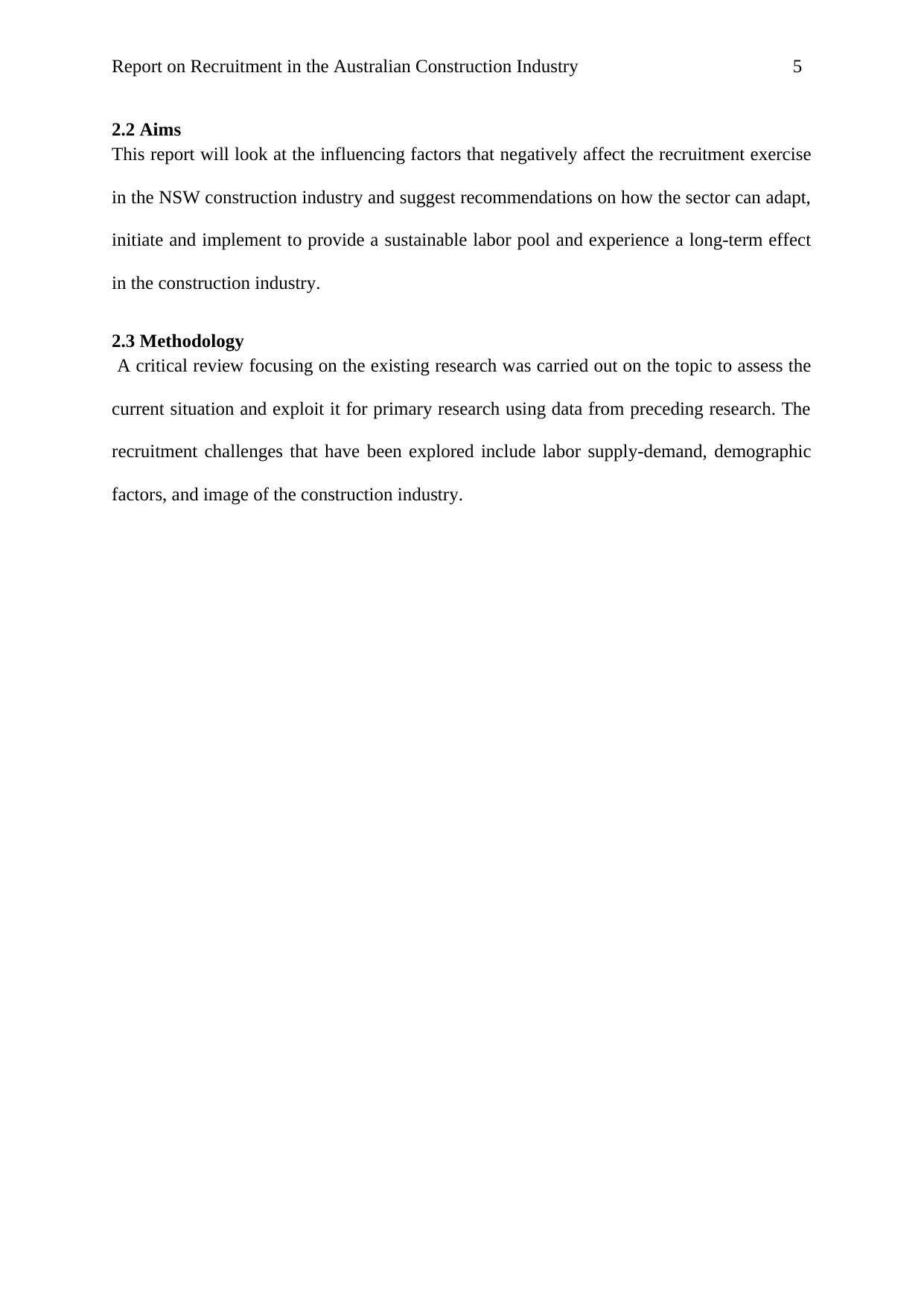
Report on Recruitment in the Australian Construction Industry 5
2.2 Aims
This report will look at the influencing factors that negatively affect the recruitment exercise
in the NSW construction industry and suggest recommendations on how the sector can adapt,
initiate and implement to provide a sustainable labor pool and experience a long-term effect
in the construction industry.
2.3 Methodology
A critical review focusing on the existing research was carried out on the topic to assess the
current situation and exploit it for primary research using data from preceding research. The
recruitment challenges that have been explored include labor supply-demand, demographic
factors, and image of the construction industry.
2.2 Aims
This report will look at the influencing factors that negatively affect the recruitment exercise
in the NSW construction industry and suggest recommendations on how the sector can adapt,
initiate and implement to provide a sustainable labor pool and experience a long-term effect
in the construction industry.
2.3 Methodology
A critical review focusing on the existing research was carried out on the topic to assess the
current situation and exploit it for primary research using data from preceding research. The
recruitment challenges that have been explored include labor supply-demand, demographic
factors, and image of the construction industry.
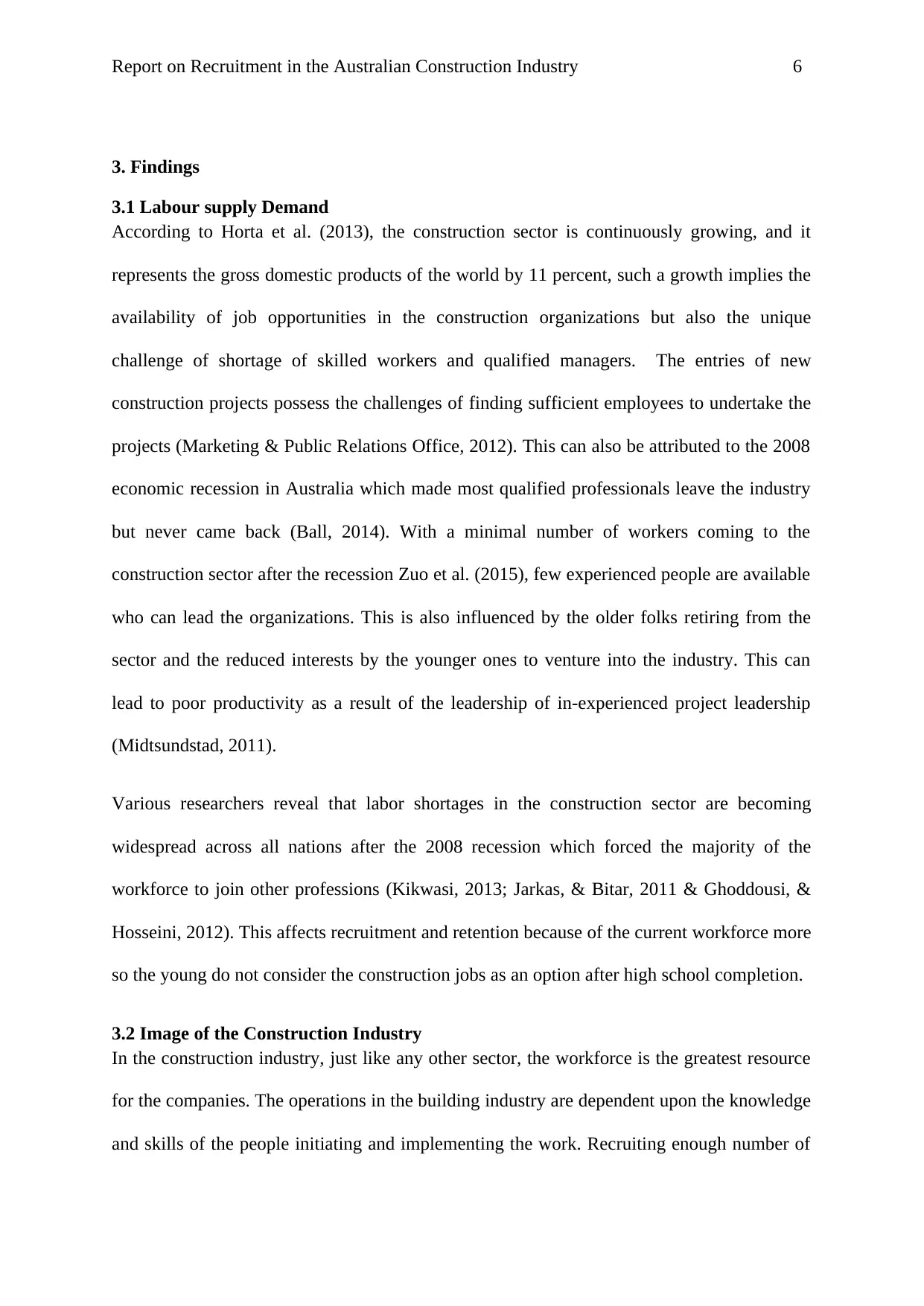
Report on Recruitment in the Australian Construction Industry 6
3. Findings
3.1 Labour supply Demand
According to Horta et al. (2013), the construction sector is continuously growing, and it
represents the gross domestic products of the world by 11 percent, such a growth implies the
availability of job opportunities in the construction organizations but also the unique
challenge of shortage of skilled workers and qualified managers. The entries of new
construction projects possess the challenges of finding sufficient employees to undertake the
projects (Marketing & Public Relations Office, 2012). This can also be attributed to the 2008
economic recession in Australia which made most qualified professionals leave the industry
but never came back (Ball, 2014). With a minimal number of workers coming to the
construction sector after the recession Zuo et al. (2015), few experienced people are available
who can lead the organizations. This is also influenced by the older folks retiring from the
sector and the reduced interests by the younger ones to venture into the industry. This can
lead to poor productivity as a result of the leadership of in-experienced project leadership
(Midtsundstad, 2011).
Various researchers reveal that labor shortages in the construction sector are becoming
widespread across all nations after the 2008 recession which forced the majority of the
workforce to join other professions (Kikwasi, 2013; Jarkas, & Bitar, 2011 & Ghoddousi, &
Hosseini, 2012). This affects recruitment and retention because of the current workforce more
so the young do not consider the construction jobs as an option after high school completion.
3.2 Image of the Construction Industry
In the construction industry, just like any other sector, the workforce is the greatest resource
for the companies. The operations in the building industry are dependent upon the knowledge
and skills of the people initiating and implementing the work. Recruiting enough number of
3. Findings
3.1 Labour supply Demand
According to Horta et al. (2013), the construction sector is continuously growing, and it
represents the gross domestic products of the world by 11 percent, such a growth implies the
availability of job opportunities in the construction organizations but also the unique
challenge of shortage of skilled workers and qualified managers. The entries of new
construction projects possess the challenges of finding sufficient employees to undertake the
projects (Marketing & Public Relations Office, 2012). This can also be attributed to the 2008
economic recession in Australia which made most qualified professionals leave the industry
but never came back (Ball, 2014). With a minimal number of workers coming to the
construction sector after the recession Zuo et al. (2015), few experienced people are available
who can lead the organizations. This is also influenced by the older folks retiring from the
sector and the reduced interests by the younger ones to venture into the industry. This can
lead to poor productivity as a result of the leadership of in-experienced project leadership
(Midtsundstad, 2011).
Various researchers reveal that labor shortages in the construction sector are becoming
widespread across all nations after the 2008 recession which forced the majority of the
workforce to join other professions (Kikwasi, 2013; Jarkas, & Bitar, 2011 & Ghoddousi, &
Hosseini, 2012). This affects recruitment and retention because of the current workforce more
so the young do not consider the construction jobs as an option after high school completion.
3.2 Image of the Construction Industry
In the construction industry, just like any other sector, the workforce is the greatest resource
for the companies. The operations in the building industry are dependent upon the knowledge
and skills of the people initiating and implementing the work. Recruiting enough number of
⊘ This is a preview!⊘
Do you want full access?
Subscribe today to unlock all pages.

Trusted by 1+ million students worldwide
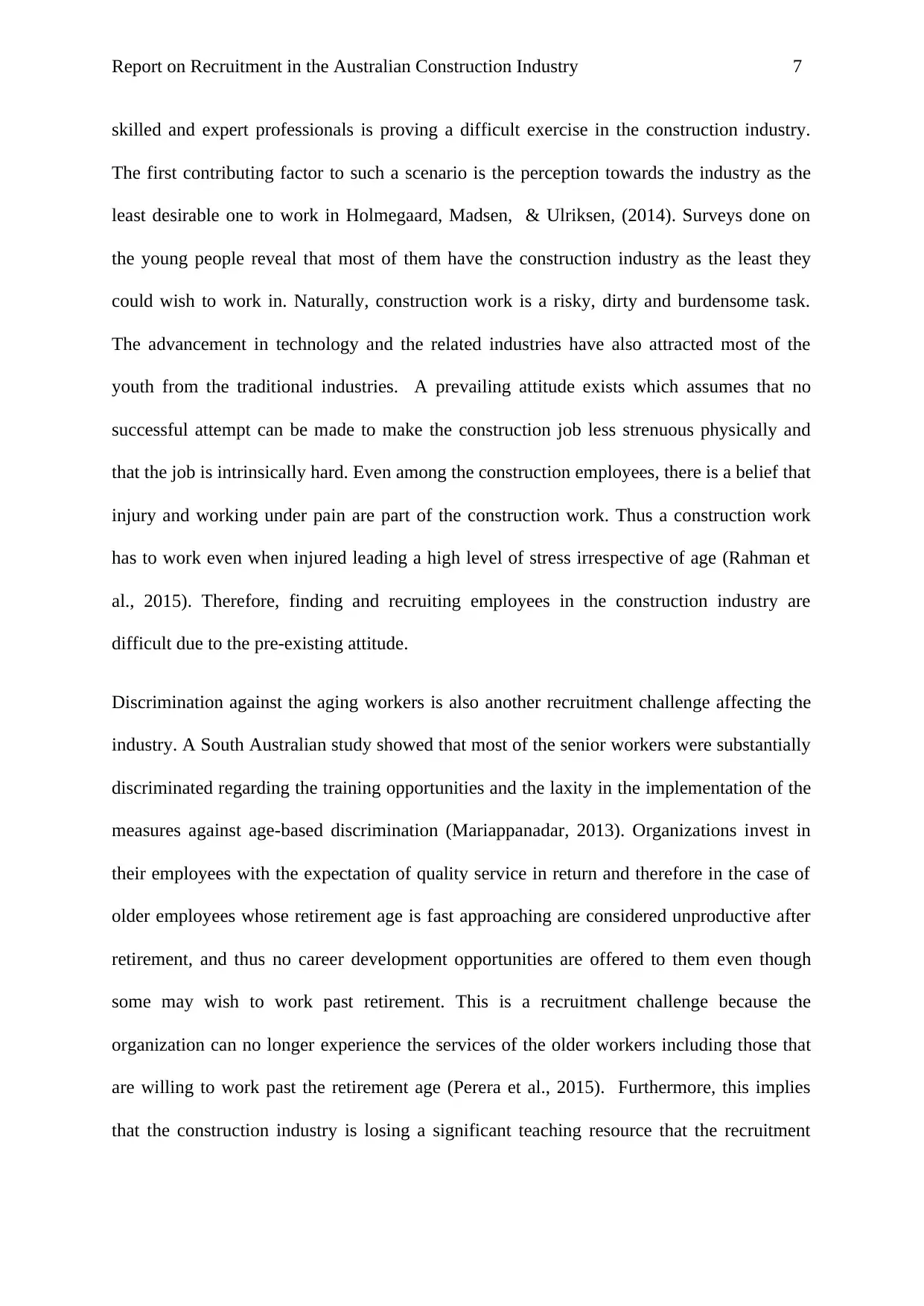
Report on Recruitment in the Australian Construction Industry 7
skilled and expert professionals is proving a difficult exercise in the construction industry.
The first contributing factor to such a scenario is the perception towards the industry as the
least desirable one to work in Holmegaard, Madsen, & Ulriksen, (2014). Surveys done on
the young people reveal that most of them have the construction industry as the least they
could wish to work in. Naturally, construction work is a risky, dirty and burdensome task.
The advancement in technology and the related industries have also attracted most of the
youth from the traditional industries. A prevailing attitude exists which assumes that no
successful attempt can be made to make the construction job less strenuous physically and
that the job is intrinsically hard. Even among the construction employees, there is a belief that
injury and working under pain are part of the construction work. Thus a construction work
has to work even when injured leading a high level of stress irrespective of age (Rahman et
al., 2015). Therefore, finding and recruiting employees in the construction industry are
difficult due to the pre-existing attitude.
Discrimination against the aging workers is also another recruitment challenge affecting the
industry. A South Australian study showed that most of the senior workers were substantially
discriminated regarding the training opportunities and the laxity in the implementation of the
measures against age-based discrimination (Mariappanadar, 2013). Organizations invest in
their employees with the expectation of quality service in return and therefore in the case of
older employees whose retirement age is fast approaching are considered unproductive after
retirement, and thus no career development opportunities are offered to them even though
some may wish to work past retirement. This is a recruitment challenge because the
organization can no longer experience the services of the older workers including those that
are willing to work past the retirement age (Perera et al., 2015). Furthermore, this implies
that the construction industry is losing a significant teaching resource that the recruitment
skilled and expert professionals is proving a difficult exercise in the construction industry.
The first contributing factor to such a scenario is the perception towards the industry as the
least desirable one to work in Holmegaard, Madsen, & Ulriksen, (2014). Surveys done on
the young people reveal that most of them have the construction industry as the least they
could wish to work in. Naturally, construction work is a risky, dirty and burdensome task.
The advancement in technology and the related industries have also attracted most of the
youth from the traditional industries. A prevailing attitude exists which assumes that no
successful attempt can be made to make the construction job less strenuous physically and
that the job is intrinsically hard. Even among the construction employees, there is a belief that
injury and working under pain are part of the construction work. Thus a construction work
has to work even when injured leading a high level of stress irrespective of age (Rahman et
al., 2015). Therefore, finding and recruiting employees in the construction industry are
difficult due to the pre-existing attitude.
Discrimination against the aging workers is also another recruitment challenge affecting the
industry. A South Australian study showed that most of the senior workers were substantially
discriminated regarding the training opportunities and the laxity in the implementation of the
measures against age-based discrimination (Mariappanadar, 2013). Organizations invest in
their employees with the expectation of quality service in return and therefore in the case of
older employees whose retirement age is fast approaching are considered unproductive after
retirement, and thus no career development opportunities are offered to them even though
some may wish to work past retirement. This is a recruitment challenge because the
organization can no longer experience the services of the older workers including those that
are willing to work past the retirement age (Perera et al., 2015). Furthermore, this implies
that the construction industry is losing a significant teaching resource that the recruitment
Paraphrase This Document
Need a fresh take? Get an instant paraphrase of this document with our AI Paraphraser
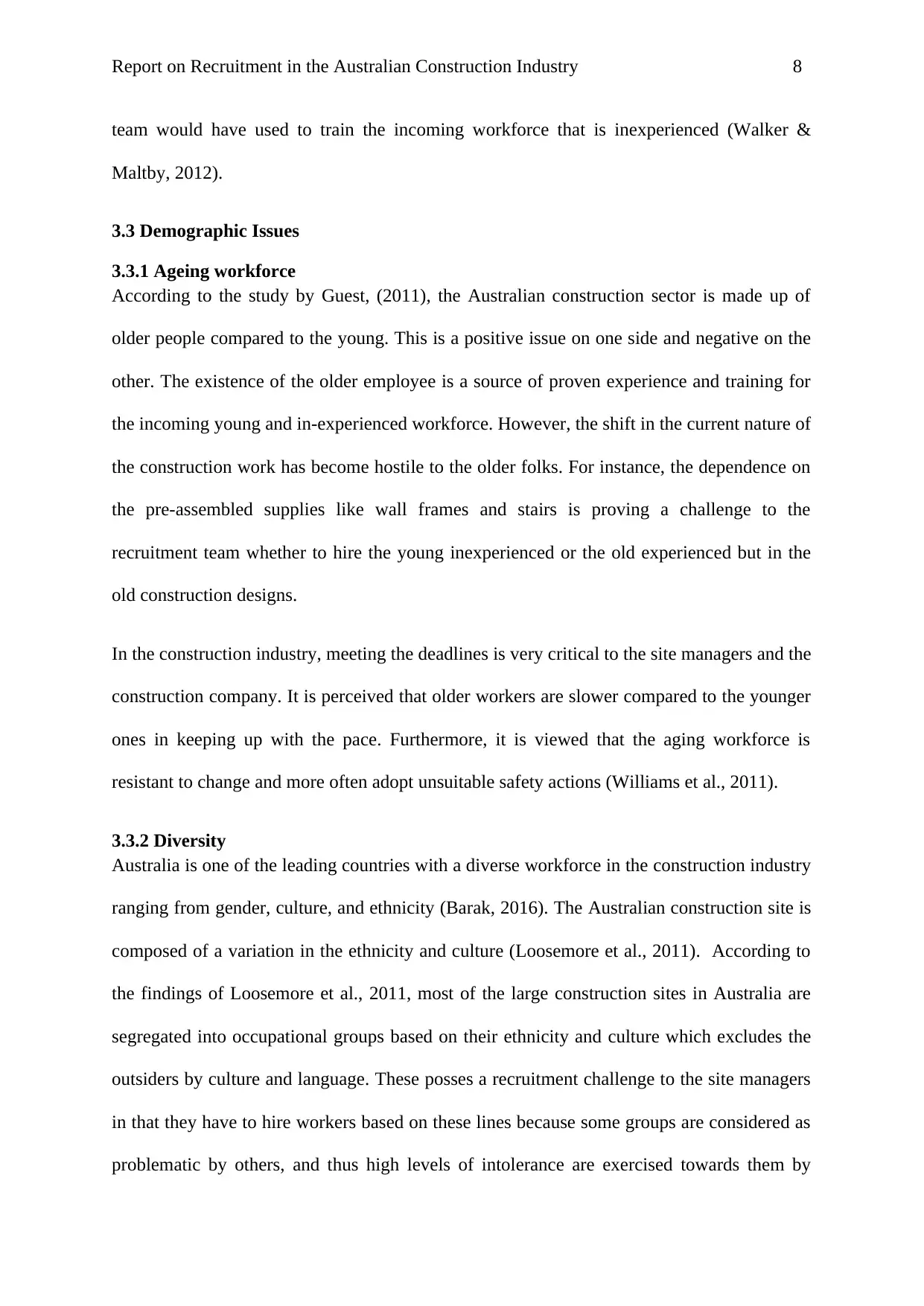
Report on Recruitment in the Australian Construction Industry 8
team would have used to train the incoming workforce that is inexperienced (Walker &
Maltby, 2012).
3.3 Demographic Issues
3.3.1 Ageing workforce
According to the study by Guest, (2011), the Australian construction sector is made up of
older people compared to the young. This is a positive issue on one side and negative on the
other. The existence of the older employee is a source of proven experience and training for
the incoming young and in-experienced workforce. However, the shift in the current nature of
the construction work has become hostile to the older folks. For instance, the dependence on
the pre-assembled supplies like wall frames and stairs is proving a challenge to the
recruitment team whether to hire the young inexperienced or the old experienced but in the
old construction designs.
In the construction industry, meeting the deadlines is very critical to the site managers and the
construction company. It is perceived that older workers are slower compared to the younger
ones in keeping up with the pace. Furthermore, it is viewed that the aging workforce is
resistant to change and more often adopt unsuitable safety actions (Williams et al., 2011).
3.3.2 Diversity
Australia is one of the leading countries with a diverse workforce in the construction industry
ranging from gender, culture, and ethnicity (Barak, 2016). The Australian construction site is
composed of a variation in the ethnicity and culture (Loosemore et al., 2011). According to
the findings of Loosemore et al., 2011, most of the large construction sites in Australia are
segregated into occupational groups based on their ethnicity and culture which excludes the
outsiders by culture and language. These posses a recruitment challenge to the site managers
in that they have to hire workers based on these lines because some groups are considered as
problematic by others, and thus high levels of intolerance are exercised towards them by
team would have used to train the incoming workforce that is inexperienced (Walker &
Maltby, 2012).
3.3 Demographic Issues
3.3.1 Ageing workforce
According to the study by Guest, (2011), the Australian construction sector is made up of
older people compared to the young. This is a positive issue on one side and negative on the
other. The existence of the older employee is a source of proven experience and training for
the incoming young and in-experienced workforce. However, the shift in the current nature of
the construction work has become hostile to the older folks. For instance, the dependence on
the pre-assembled supplies like wall frames and stairs is proving a challenge to the
recruitment team whether to hire the young inexperienced or the old experienced but in the
old construction designs.
In the construction industry, meeting the deadlines is very critical to the site managers and the
construction company. It is perceived that older workers are slower compared to the younger
ones in keeping up with the pace. Furthermore, it is viewed that the aging workforce is
resistant to change and more often adopt unsuitable safety actions (Williams et al., 2011).
3.3.2 Diversity
Australia is one of the leading countries with a diverse workforce in the construction industry
ranging from gender, culture, and ethnicity (Barak, 2016). The Australian construction site is
composed of a variation in the ethnicity and culture (Loosemore et al., 2011). According to
the findings of Loosemore et al., 2011, most of the large construction sites in Australia are
segregated into occupational groups based on their ethnicity and culture which excludes the
outsiders by culture and language. These posses a recruitment challenge to the site managers
in that they have to hire workers based on these lines because some groups are considered as
problematic by others, and thus high levels of intolerance are exercised towards them by
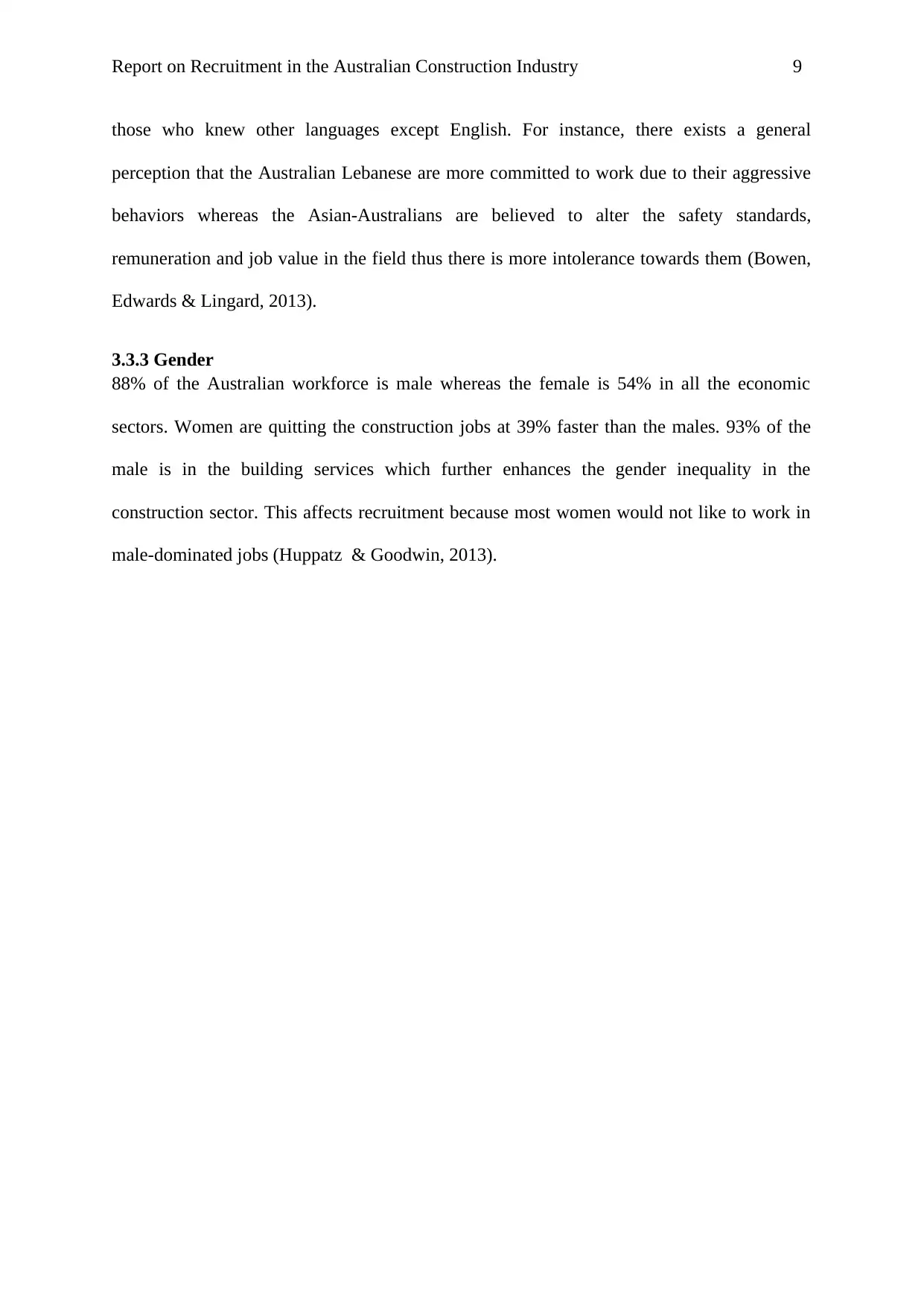
Report on Recruitment in the Australian Construction Industry 9
those who knew other languages except English. For instance, there exists a general
perception that the Australian Lebanese are more committed to work due to their aggressive
behaviors whereas the Asian-Australians are believed to alter the safety standards,
remuneration and job value in the field thus there is more intolerance towards them (Bowen,
Edwards & Lingard, 2013).
3.3.3 Gender
88% of the Australian workforce is male whereas the female is 54% in all the economic
sectors. Women are quitting the construction jobs at 39% faster than the males. 93% of the
male is in the building services which further enhances the gender inequality in the
construction sector. This affects recruitment because most women would not like to work in
male-dominated jobs (Huppatz & Goodwin, 2013).
those who knew other languages except English. For instance, there exists a general
perception that the Australian Lebanese are more committed to work due to their aggressive
behaviors whereas the Asian-Australians are believed to alter the safety standards,
remuneration and job value in the field thus there is more intolerance towards them (Bowen,
Edwards & Lingard, 2013).
3.3.3 Gender
88% of the Australian workforce is male whereas the female is 54% in all the economic
sectors. Women are quitting the construction jobs at 39% faster than the males. 93% of the
male is in the building services which further enhances the gender inequality in the
construction sector. This affects recruitment because most women would not like to work in
male-dominated jobs (Huppatz & Goodwin, 2013).
⊘ This is a preview!⊘
Do you want full access?
Subscribe today to unlock all pages.

Trusted by 1+ million students worldwide
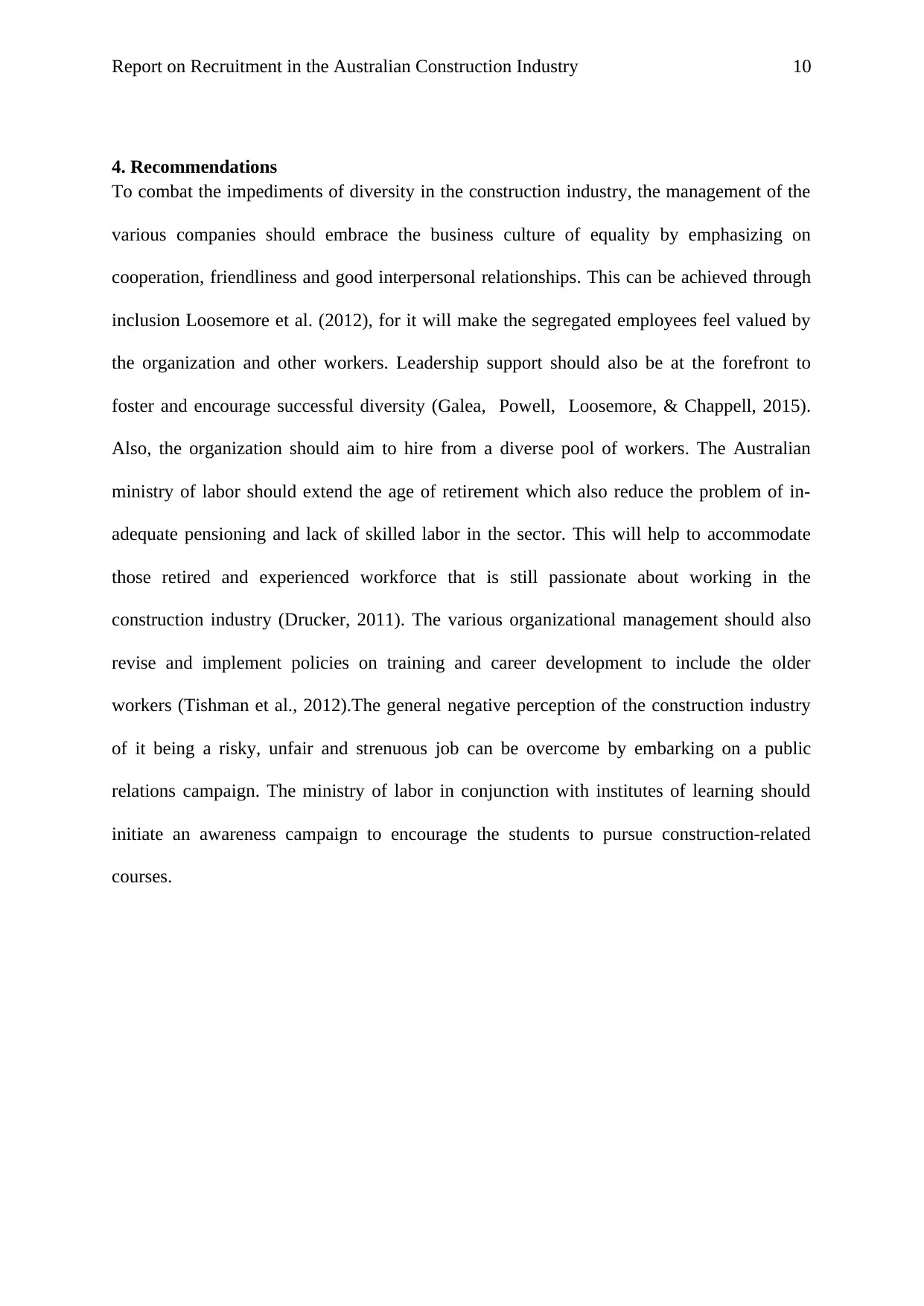
Report on Recruitment in the Australian Construction Industry 10
4. Recommendations
To combat the impediments of diversity in the construction industry, the management of the
various companies should embrace the business culture of equality by emphasizing on
cooperation, friendliness and good interpersonal relationships. This can be achieved through
inclusion Loosemore et al. (2012), for it will make the segregated employees feel valued by
the organization and other workers. Leadership support should also be at the forefront to
foster and encourage successful diversity (Galea, Powell, Loosemore, & Chappell, 2015).
Also, the organization should aim to hire from a diverse pool of workers. The Australian
ministry of labor should extend the age of retirement which also reduce the problem of in-
adequate pensioning and lack of skilled labor in the sector. This will help to accommodate
those retired and experienced workforce that is still passionate about working in the
construction industry (Drucker, 2011). The various organizational management should also
revise and implement policies on training and career development to include the older
workers (Tishman et al., 2012).The general negative perception of the construction industry
of it being a risky, unfair and strenuous job can be overcome by embarking on a public
relations campaign. The ministry of labor in conjunction with institutes of learning should
initiate an awareness campaign to encourage the students to pursue construction-related
courses.
4. Recommendations
To combat the impediments of diversity in the construction industry, the management of the
various companies should embrace the business culture of equality by emphasizing on
cooperation, friendliness and good interpersonal relationships. This can be achieved through
inclusion Loosemore et al. (2012), for it will make the segregated employees feel valued by
the organization and other workers. Leadership support should also be at the forefront to
foster and encourage successful diversity (Galea, Powell, Loosemore, & Chappell, 2015).
Also, the organization should aim to hire from a diverse pool of workers. The Australian
ministry of labor should extend the age of retirement which also reduce the problem of in-
adequate pensioning and lack of skilled labor in the sector. This will help to accommodate
those retired and experienced workforce that is still passionate about working in the
construction industry (Drucker, 2011). The various organizational management should also
revise and implement policies on training and career development to include the older
workers (Tishman et al., 2012).The general negative perception of the construction industry
of it being a risky, unfair and strenuous job can be overcome by embarking on a public
relations campaign. The ministry of labor in conjunction with institutes of learning should
initiate an awareness campaign to encourage the students to pursue construction-related
courses.
Paraphrase This Document
Need a fresh take? Get an instant paraphrase of this document with our AI Paraphraser
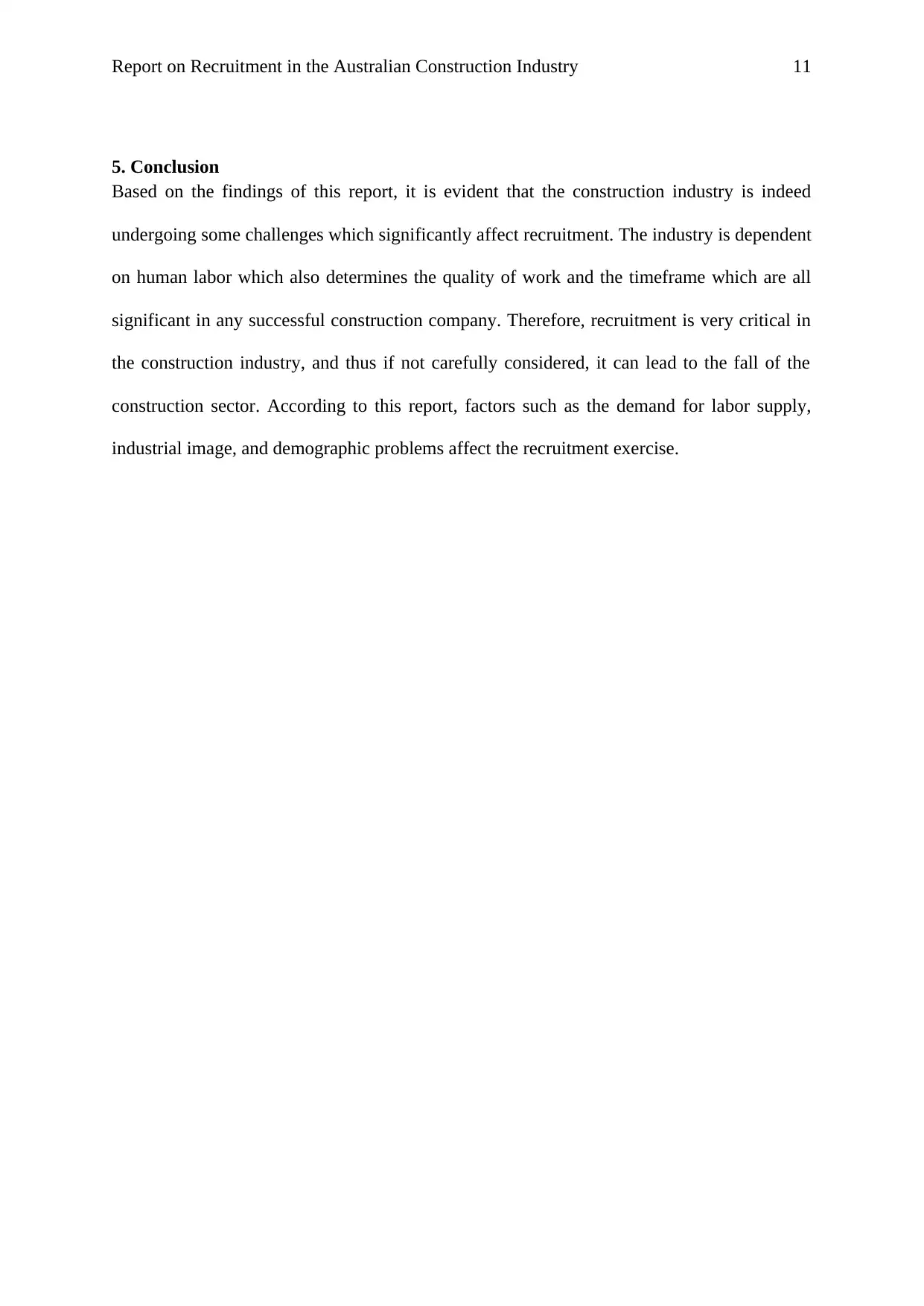
Report on Recruitment in the Australian Construction Industry 11
5. Conclusion
Based on the findings of this report, it is evident that the construction industry is indeed
undergoing some challenges which significantly affect recruitment. The industry is dependent
on human labor which also determines the quality of work and the timeframe which are all
significant in any successful construction company. Therefore, recruitment is very critical in
the construction industry, and thus if not carefully considered, it can lead to the fall of the
construction sector. According to this report, factors such as the demand for labor supply,
industrial image, and demographic problems affect the recruitment exercise.
5. Conclusion
Based on the findings of this report, it is evident that the construction industry is indeed
undergoing some challenges which significantly affect recruitment. The industry is dependent
on human labor which also determines the quality of work and the timeframe which are all
significant in any successful construction company. Therefore, recruitment is very critical in
the construction industry, and thus if not carefully considered, it can lead to the fall of the
construction sector. According to this report, factors such as the demand for labor supply,
industrial image, and demographic problems affect the recruitment exercise.
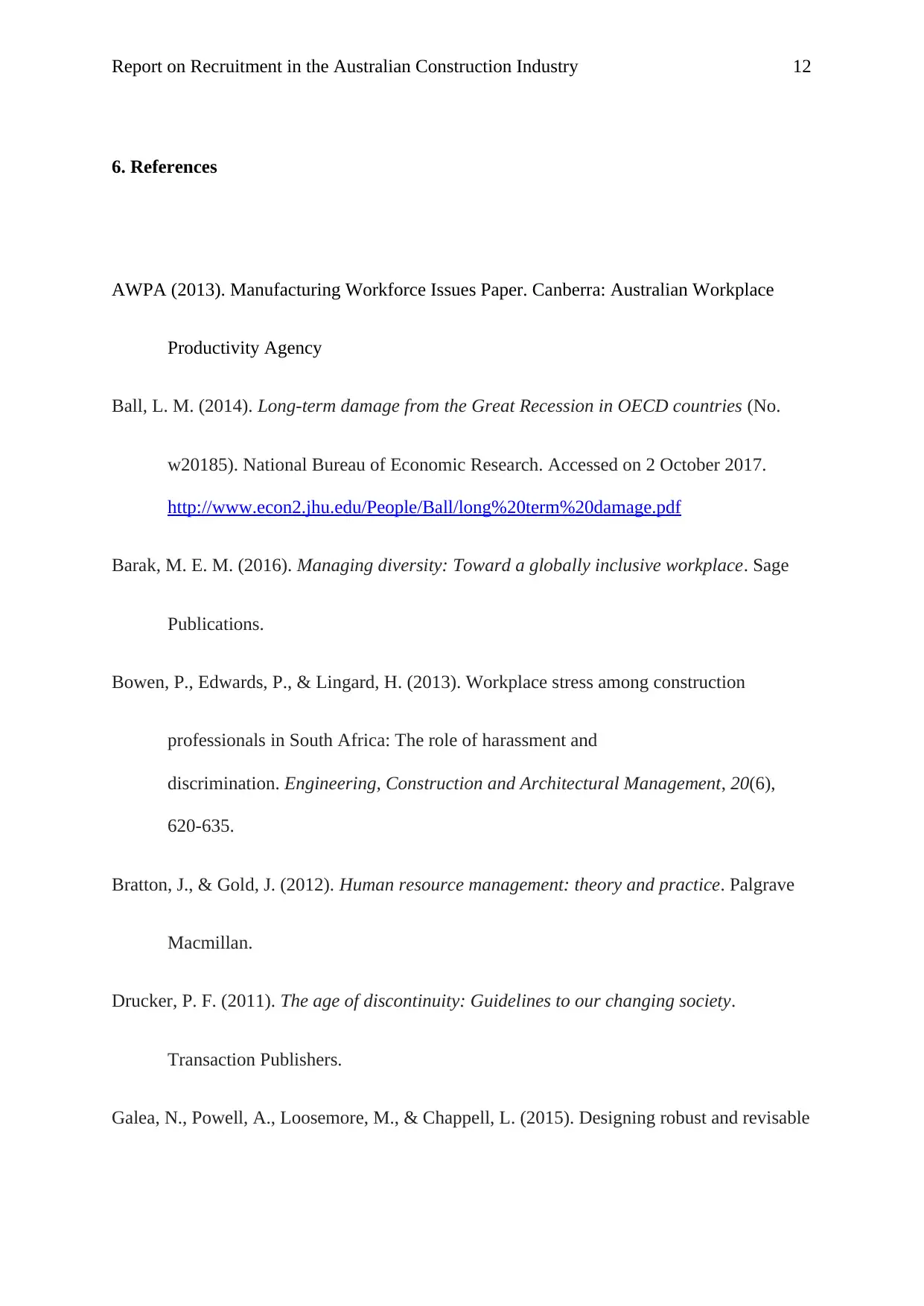
Report on Recruitment in the Australian Construction Industry 12
6. References
AWPA (2013). Manufacturing Workforce Issues Paper. Canberra: Australian Workplace
Productivity Agency
Ball, L. M. (2014). Long-term damage from the Great Recession in OECD countries (No.
w20185). National Bureau of Economic Research. Accessed on 2 October 2017.
http://www.econ2.jhu.edu/People/Ball/long%20term%20damage.pdf
Barak, M. E. M. (2016). Managing diversity: Toward a globally inclusive workplace. Sage
Publications.
Bowen, P., Edwards, P., & Lingard, H. (2013). Workplace stress among construction
professionals in South Africa: The role of harassment and
discrimination. Engineering, Construction and Architectural Management, 20(6),
620-635.
Bratton, J., & Gold, J. (2012). Human resource management: theory and practice. Palgrave
Macmillan.
Drucker, P. F. (2011). The age of discontinuity: Guidelines to our changing society.
Transaction Publishers.
Galea, N., Powell, A., Loosemore, M., & Chappell, L. (2015). Designing robust and revisable
6. References
AWPA (2013). Manufacturing Workforce Issues Paper. Canberra: Australian Workplace
Productivity Agency
Ball, L. M. (2014). Long-term damage from the Great Recession in OECD countries (No.
w20185). National Bureau of Economic Research. Accessed on 2 October 2017.
http://www.econ2.jhu.edu/People/Ball/long%20term%20damage.pdf
Barak, M. E. M. (2016). Managing diversity: Toward a globally inclusive workplace. Sage
Publications.
Bowen, P., Edwards, P., & Lingard, H. (2013). Workplace stress among construction
professionals in South Africa: The role of harassment and
discrimination. Engineering, Construction and Architectural Management, 20(6),
620-635.
Bratton, J., & Gold, J. (2012). Human resource management: theory and practice. Palgrave
Macmillan.
Drucker, P. F. (2011). The age of discontinuity: Guidelines to our changing society.
Transaction Publishers.
Galea, N., Powell, A., Loosemore, M., & Chappell, L. (2015). Designing robust and revisable
⊘ This is a preview!⊘
Do you want full access?
Subscribe today to unlock all pages.

Trusted by 1+ million students worldwide
1 out of 16
Related Documents
Your All-in-One AI-Powered Toolkit for Academic Success.
+13062052269
info@desklib.com
Available 24*7 on WhatsApp / Email
![[object Object]](/_next/static/media/star-bottom.7253800d.svg)
Unlock your academic potential
Copyright © 2020–2025 A2Z Services. All Rights Reserved. Developed and managed by ZUCOL.





